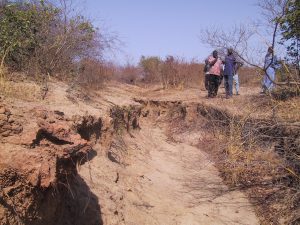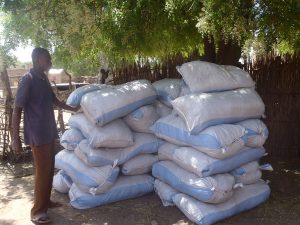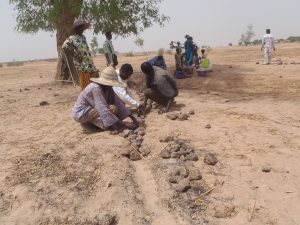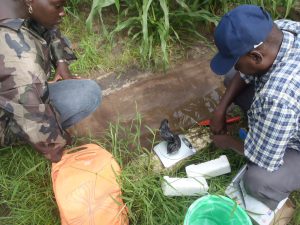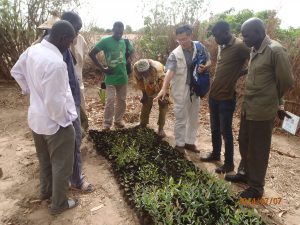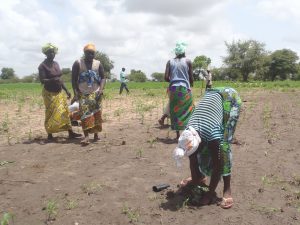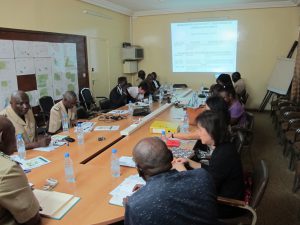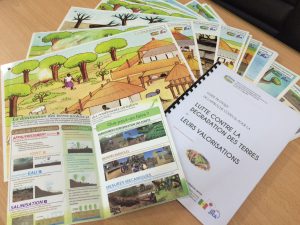#Land degradation, #Technical manual, #Involvement of local communities
Project Overview
Strengthen human resource capacities so that activities to combat land degradation and promote its recovery are carried out continuously by local people themselves.
The fight against deforestation and land degradation is one of the political priorities of the Government of Senegal in the environmental sector. To date, several projects and programs have been carried out in this area. However, there is still the challenge of continuity in the implementation of activities by local people after the completion of projects/programs, and the insufficiency of capitalization on the results by relevant stakeholders.
For this reason, it is necessary to capitalize on acquired knowledge, identify and test appropriate and applicable techniques and methods, strengthen the capacities of those concerned (forestry agents, local people, local communities, etc.), implement a strategy to leverage the knowledge gained, and set up a scheme for ensuring continuation of achievements in the field. In order to address these issues, the Government of Senegal requested this project to the Japanese Government. Based on this request, the Japan International Cooperation Agency (JICA) launched the “capacity building project for controlling land degradation and promoting its recovery in degraded soil areas (CODEVAL)” which began in March 2011, in collaboration with the Directorate of Water, Forest, Hunting and Soil Conservation of the Ministry for the Environment and Sustainable Development as a counterpart institution (C/P).
The objective of the project is to enhance the capacities of human resources (forestry agents, local people, local communities, etc.), so that activities to combat land degradation and promote its recovery are carried out continuously by local people themselves with support from forestry agents, local communities and other local partners after the completion of the project.
The project was completed in February 2016.
Project Details
1. Basic information
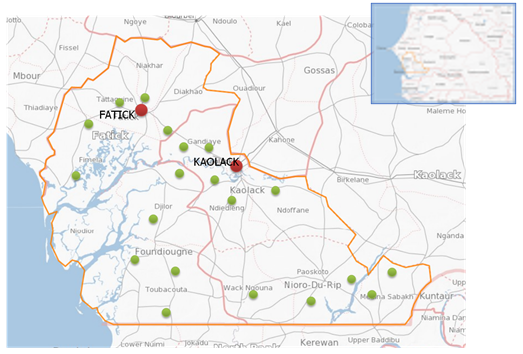 The expansion of bare land or land with low plant cover (soils with a high sulfuric acid content), salinization of the soil, and weakening of the soil (resulting from the excessive practice of monoculture in the groundnut basin*1 or overgrazing), are all major problems currently encountered in Senegal. In particular, the reduction of arable land and that of forest areas, or the reduction of cereal yields, etc., per unit area continues to increase in Fatick region and Kaolack region targeted by the Project. These two regions are experiencing two major problems related to prevalence of soils with a high sulfuric acid content, and the weakening of topsoil. Such problems have a major impact on the lives of rural populations in these two regions, which are characterized by strong demographic growth.
The expansion of bare land or land with low plant cover (soils with a high sulfuric acid content), salinization of the soil, and weakening of the soil (resulting from the excessive practice of monoculture in the groundnut basin*1 or overgrazing), are all major problems currently encountered in Senegal. In particular, the reduction of arable land and that of forest areas, or the reduction of cereal yields, etc., per unit area continues to increase in Fatick region and Kaolack region targeted by the Project. These two regions are experiencing two major problems related to prevalence of soils with a high sulfuric acid content, and the weakening of topsoil. Such problems have a major impact on the lives of rural populations in these two regions, which are characterized by strong demographic growth.
The project implementation strategy is composed of 4 grand activities, namely “Activities to grasp the local situation”, “Identification of techniques and methods”, “Experiments and capitalization on results at 20 pilot sites” and “Scaling-up at the 80 priority sites”. Regarding testing the identified techniques and methods at 20 pilot sites, the project did not only take into consideration the countermeasures against land degradation, but also considered additional activities related to income generation.
*1 The groundnut basin includes the regions of Thies, Louga, Diourbel, Fatick, and Kaolack.
2. Activities to grasp the local situation
It is crucial for the project to have enough information on the target area before undertaking an appropriate approach to cope with the issues related to land degradation. In order to grasp the local situation on its current status of land degradation, to identify the appropriate techniques and methods, and to select the target sites, some studies were carried out at the start of the project on existing techniques and methods and soil degradation processes analysis. Additionally, thematic maps were created, and pilot sites and priority sites were then chosen.
- Water erosion
- Workshop for selecting priority sites
3. Identification of techniques and methods
Following a survey of the local situation, technical options applicable to local people were selected, following observation visits and interviews conducted through focus groups. When determining the activities to be undertaken at different sites, the project proposed local communities a combination of techniques adapted to each particular site, taking the types of degradation into account. The final decision was made with the consent of the village assembly at the various target sites.
- Local seminar to launch the activities
- Launch meeting of activities in a pilot site
4. Experiments and capitalization on results at 20 pilot sites
The techniques and methods selected were tested at the pilot sites. At the same time, income-earning activities were carried out to create beneficial spin-offs, such as the efficient use of compost produced by the techniques applied, and increased motivation of people relative to their participation in the activities.
| Type | Technique applied |
| Water erosion countermeasures | ✔ Frame dike, stone band, with grass strips
✔ Improvement of cultivation techniques to prevent water erosion |
| Wind erosion countermeasures | ✔ Planting of windbreaks, planting of hedges
✔ Intercropping (associated culture) ✔ Placement of improved fallow-band system |
| Salinization countermeasures/
improvement of soil fertility |
✔ Improved composting facilities
✔ Agroforestry/hedgerow farming ✔ Assisted natural regeneration (ANR) + reforestation ✔ Prevention of land degradation and improvement of soil fertility by improved farming methods ✔ Forest conservation (support for defenses, etc.) ✔ Planting of halophytic species and herbaceous plants ✔ Popularization of ECOSAN latrines ✔ Support for village nurseries |
| Income-earning activities | ✔ Planting of income-earning crops
✔ Market gardening |
- Products (compost) from improved composting
- Construction of stone barriers
- Measurements of soil erosion
- Production of vegetables
- Village nursery
- Reforestation in a cereal field
5. Scaling-up at the 80 priority sites
Manuals and technical catalogues were prepared by the Project combating land degradation in collaboration with FORESTRY TRAINING AND RECYCLING CENTER IN THIES (FoReT Center).
The forestry officers in the target areas carried out visits to scale-up appropriate techniques and methods at the 80 priority sites in the regions of Fatick and Kaolack. In addition, the Project designed and implemented a scaling-up approach: “Local and School Green Activities (AVLOS)”, based on the involvement of local authorities and enhancement of the educational network. At the same time, the Project developed an awareness resource, “SARAR/CODEVAL”, which is an adaptation of the SARAR/PHAST*2 method often used in the health and hygiene field. The SARAR/PHAST method consists in promoting behavioral changes by triggering awareness among people in order to make them self-sufficient. These tools for awareness-raising have been distributed to forestry and agricultural agents, but also on a larger scale to relevant parties such as local authorities and those involved in the educational sector.
- Workshop to develop a practical guide
- Practical guide, technical catalogue and tools for awareness-raising created by the Project
*2 “PHAST” stands for “Participatory Hygiene and Sanitation Transformation”, a joint programme of WHO and the UNDP/World Bank Water and Sanitation Program (WSP), and is an awareness-raising method in the public health using a participatory approach called “SARAR”. SARAR stands for “Self-esteem, Associative strength, Resourcefulness, Action-planning, and Responsibility”. “PHAST” stands for “Participatory Hygiene and Sanitation Transformation”, a joint programme of WHO and the UNDP/World Bank Water and Sanitation Program (WSP), and is an awareness-raising method in the public health using a participatory approach called “SARAR”. SARAR stands for “Self-esteem, Associative strength, Resourcefulness, Action-planning, and Responsibility”.
For further information, please consult the manuals and reports
The guides, manuals and tools produced within the framework of the project for the training, scaling-up and awareness can be downloaded from the links below. These approaches can be applied to other countries in arid/semi-arid areas!
Reports
・[FR] FINAL REPORT OF THE CODEVAL PROJECT
Written by Yusuke Goto,
AI-CD Secretariat Support Team/Earth and Human Corporation,
Former Team Leader of CODEVAL project

